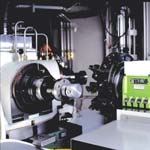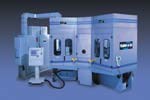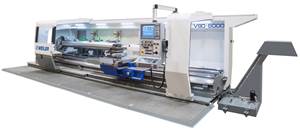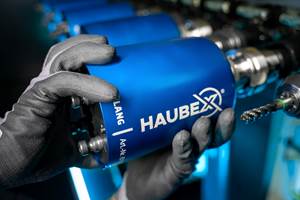Multi-Station Repeatability Enhances Quality For Complex Parts
Flexible automation is making production machining a new opportunity for shops that traditionally did not seek this kind of work. At the same time, automated machining systems are taking new shapes and configurations that favor this trend. A recently introduced example is the Turn 6 LC from ATS.
Flexible automation is making production machining a new opportunity for shops that traditionally did not seek this kind of work. At the same time, automated machining systems are taking new shapes and configurations that favor this trend. A recently introduced example is the Turn 6 LC from Automation Tooling Systems (ATS) of Cambridge, Ontario. According to the company, this model offers multi-station CNC turning and machining in a completely new format. This medium- to high-volume machining technology combines up to six CNC precision chucking spindles, mounted on a "Hirth coupling" main indexing rotary transfer table. The system performs five-sided machining (turning, milling, drilling and tapping) for complete part production. Most operations require only a single clamping.
Apparently, the development of this system was driven by market need, specifically the ability to combine multiple turning and machining processes on one machine. Jeff Palser, sales and marketing manager for ATS Machine Tool Division, explains that the new machine fills a niche in the "chucking" machining market for companies that produce complex components in high volume, from bar stock, castings or forgings. "In applications typically requiring several dedicated CNC cells, this technology offers enormous advantages in productivity and cost," he claims. In addition, he says, because of the "clamp once" repeatability the machine can deliver, it offers final part quality that is very difficult to attain with conventional equipment linked with in-line transfer automation.
Using an indexing dial as a starting point, ATS configured the new machine around a central "Hirth coupling" main index table, incorporating as many as six motorized chucking spindles mounted on the servodriven rotary transfer unit. This configuration is designed to optimize both the station-to-station transfer cycle and accuracy.
The machine can be set up for either manual or automated load/unload at the first station, while the remaining five spindles are simultaneously in cut. According to Mr. Palser, this approach helps keep "chip-to-chip" times very low. Flexibility in tooling and CNC control allows many workpieces to be machined on five sides, with no secondary operations required. Because the workpiece is clamped only once, location and orientation are maintained from station to station.
Each station is equipped with modular two-axis CNC units, with a work envelope as large as 8 inches. Tooling options include single or twin horizontal/vertical tool spindles, multi-tool turrets and conventional toolholders. The machine can perform both on-center and off-center machining operations. CNC capability allows for single-point machining of complex forms, grooves or undercuts using conventional turning tools and G-code programming logic. Infinitely variable positioning through 360 degrees on the C axis facilitates accurate off-center milling, drilling or tapping processes. In addition, enhanced concentricity can be achieved by rotating both the workpiece and the cutting tool. Counter-rotating spindles can be employed to achieve high cutting speeds during light-cut finishing operations.
The tool spindle motors, nominally rated at 5 kW, are mounted on dual-axis servo controlled CNC slide units. The tool spindles are synchronized with the chuck spindles, rated at 12 kW. This arrangement facilitates polygon turning and on-the-fly part swapping to a secondary spindle in applications where double endwork is required. All spindles are independently servo controlled for speeds from 0 to 10,000 rpm, allowing feeds and speeds to be matched to each process step.
Options for this machine include high-pressure through-spindle coolant, a variety of load/unload material handling automation and active tool monitoring. Procedural training manuals are available online through the machine control.
Related Content
Weiler to Debut New Automation Features For Its Lathes
Weiler’s V 110 four-way precision lathe introduces features new to the U.S.
Read MoreUsing the Toolchanger to Automate Production
Taking advantage of a feature that’s already on the machine tool, Lang’s Haubex system uses the toolchanger to move and store parts, making it an easy-to-use and cost-effective automation solution.
Read MoreInside the Premium Machine Shop Making Fasteners
AMPG can’t help but take risks — its management doesn’t know how to run machines. But these risks have enabled it to become a runaway success in its market.
Read MoreWhich Approach to Automation Fits Your CNC Machine Tool?
Choosing the right automation to pair with a CNC machine tool cell means weighing various factors, as this fabrication business has learned well.
Read MoreRead Next
3 Mistakes That Cause CNC Programs to Fail
Despite enhancements to manufacturing technology, there are still issues today that can cause programs to fail. These failures can cause lost time, scrapped parts, damaged machines and even injured operators.
Read MoreThe Cut Scene: The Finer Details of Large-Format Machining
Small details and features can have an outsized impact on large parts, such as Barbco’s collapsible utility drill head.
Read More












.png;maxWidth=300;quality=90)

.png;maxWidth=300;quality=90)












